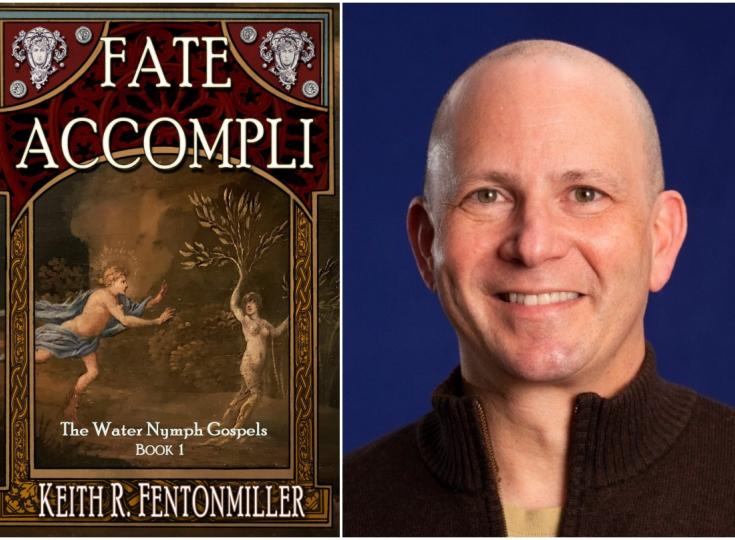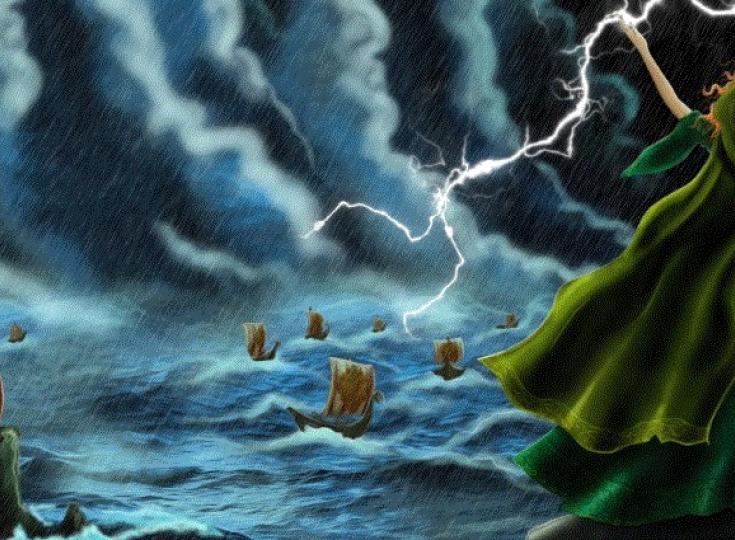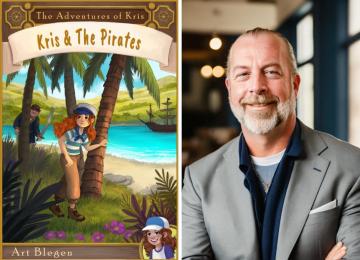Keith R. Fentonmiller - Spinning Gods and Mortals Into a Richly Woven Tapestry of Myth, Magic, Humor, and Romance

Keith recently published Fate Accompli: The Water Nymph Gospels, Book 1 (Ellysian Press), the first book in his new historical fantasy series. About Fate Accompli, The Historical Novel Society says, “A delightful dry wit saturates the prose, playing perfectly into the absurdity surrounding certain myths.” Keith’s debut fantasy novel, Kasper Mützenmacher’s Cursed Hat (Curiosity Quills, 2017), was a Foreword INDIES Finalist in the Adult Fantasy category and was shortlisted for the editor’s prize. Kirkus Review praised Cursed Hat as “an undeniably imaginative journey.” Keith has published short stories in the Stone Coast Review (Pushcart-nominated) and Running Wild Press, and online humor pieces with The Satirist and Defenestration. He is a consumer protection attorney for the U.S. Federal Trade Commission in Washington, D.C. and lives in Kensington, Maryland. As our Author of the Day he tells us all about Fate Accompli.
Please give us a short introduction to what Fate Accompli is about.
Fate Accompli is the first book in a humorous historical fantasy series called The Water Nymph Gospels. The story shows the Greek gods’ pettiness and greed through the eyes of a primordial goddess named Moira, a weaver from Tartarus who becomes the embodiment of Fate. Later, we meet Andolosia Petasos, a hat-maker from the Italian Renaissance who dreams of becoming the next Leonardo Da Vinci. Unfortunately, Andolosia is cursed to make hats because his Greek ancestor stole the god Hermes’ teleportation hat back in the fourth century. Unless Andolosia can return Hermes’ hat, he must remain in the hat business — no easy task, given that Hermes has been trapped in Oblivion for twelve centuries.
And then there’s Carlotta Lux. Carlotta is a feisty Sicilian who dreams of building bridges and dams. But her aspirations face two significant obstacles. First, she’s a woman in the early 17th century. Second, like Andolosia, she is cursed. Her ancestor was Daphne, the mythical water nymph who turned into a laurel tree while fleeing Apollo’s sexual advances. Apollo, however, did not abandon the chase after Olympus fell. For centuries, he has been escaping Oblivion, possessing mortal men, and pursuing Daphne’s human descendants.
Andolosia stumbles upon Carlotta while delivering a custom hat to the palazzo of the powerful Sansone de Medici. Apollo has possessed Sansone and taken Carlotta prisoner. When Andolosia uses Hermes’ hat to teleport Carlotta away, the divinely-possessed Sansone pursues them with a vengeance.
Fate Accompli’s narrative style is a mix of the absurd, noir, romance, and philosophical reflection.
What inspired you to write about a cursed hatmaker who faces Olympian peril?
A proper answer to this question would require me to undergo years of hypnotherapy and three or four vision quests. The truth is, I have no idea. My favorite stories tend to blend realism and fantasy or explore the intersection of the waking and dream worlds. Hats in particular have fascinated me since reading the Berenstain Bears book Old Hat, New Hat. I love the whimsical hat designs in that book and the silliness that arises from the customer’s fussiness. When I grew up, my interests expanded from odd hats to philosophy and sketch comedy. The Water Nymph Gospels draws on history, mythology, humor, and narrative to grapple with philosophical concepts like free will, the tension between faith and science, and the idea that creation and nothingness are two sides of the same coin. Hats are an especially good metaphor for the latter notion. After all, what is a hat but fabric skillfully wrapped around empty space?
What fascinates you about Ancient Greece and the Italian Renaissance?
Both epochs were vibrant with art, science, and philosophy., both rich with deep thinkers and inventors. Both periods confronted the relationship between reason and faith. In Ancient Greece, Thales tried to understand the elements independently of the gods, while in Italy, Galileo challenged Church orthodoxy about an Earth-centered universe. Both time periods experienced the benefits and stresses of multiculturalism. When Greek city-states weren’t battling, they were commercial partners. Some Italian port cities were a melting pot of native Italians, Spanish Jews, Africans, and Muslims. In this sense, the challenges and achievements of the past are no different than those of the present.
Tell us more about Moira. What makes her tick?
Moira, the goddess we come to know as Fate, is a weaver at heart. She finds meaning through the creative process. Her night-sky curtains and fate tapestries serve more than utilitarian purposes. They are tangible expressions of Moira’s soul. She is happiest working the loom, weaving rich stories in her unique tactile language.
Besides writing, what other secret skills do you have?
If I revealed my secret skills, they would no longer be secret skills, now would they? That said, it is no secret that I am a lawyer. I have practiced law for a long time, which indicates that I have either developed sound legal skills or was born with a natural talent for disguising my lack of legal skills.
Which of your characters was the most fun to create and why?
I am reticent to pick a favorite character, especially when jealous gods are involved, but I will risk it for the sake of edifying your readers. I had a lot of fun with the Titan god Cronus. He is an articulate fop, the type of character that Charles Dickens and Monty Python mastered. Bestowing him with verbal tics, sexual awkwardness, and a generally doughy appearance brought his voice alive in my head.
How much research did this story require from you to make the history feel authentic? What was the most interesting aspect of this research?
For me, the key is verisimilitude. Although I strive for historical accuracy, there comes a point when spending more time figuring out whether people used corn cobs or oak leaves to wipe their bottoms would be better spent on developing the characters and their conflicts — the exception being if the characters are having a heated argument about corn cobs versus oak leaves. Ultimately, I am writing a story, not a historical tome. I want to give readers a feel for the time and place without bogging them down in minutiae. After learning as much as I can about day to day life in the relevant era, I set that knowledge aside. Then, when I write a scene, I can insert particular historical details to create a flavor of the time period. This way, history serves the narrative and not the other way around.
Much of Fate Accompli takes place in Tuscany in 1603, when the Medici family was expanding Livorno from a sleepy village of five-hundred souls into a major commercial port with ten thousand inhabitants from diverse religious and cultural backgrounds. I tracked down scholarly resources about what life might have been like in Livorno, the types of ships and goods that passed through the harbor, the role of commercial guilds, the outsized influence of the Medici, the Spanish Inquisition, and the state of scientific technology. Believe it or not, all these elements were important for a story centered around curses, water nymphs, and Greek gods. The most interesting discoveries I made took place at the Library of Congress. I came across account ledgers detailing goods coming in and out of the Port of Livorno as well as a handbill advising sailors where to locate an apothecary with treatments for venereal disease.
Is there an underlying message you wish to relay about basic human nature through your characters?
The underlying message of the book is amor fati, which is a Latin phrase that means to love one’s fate. There is little we can directly control or freely choose except for the choice to embrace the reality that life is part of an infinite wheel of birth, death, and rebirth. Philosopher Viktor Frankl wrote that we have freedom to find meaning in what we do and what we experience or at least to choose the stance we take when faced with a situation of unchangeable suffering. I take that a step further. We can choose to laugh at the darkness.
Do you ever suffer from writer’s block? If so, what do you do to combat it?
Not often, but when I do, I find it helpful to use a favorite book as a template for whatever it is I’m struggling to write. I will find an excerpt, such as a description of a setting, an internal monologue, or a scene that seems to capture the flavor and rhythm of what I’m striving to write. I’ll then substitute my words to make the excerpt fit the particulars of my story. Usually, this exercise greases the creative wheels enough that I can carry on from there.
Are you a plotter or a pantser? Do you plan out your entire plot before you start writing?
I recently heard a writer describe herself as a “plantser.” That does not mean she smokes special plants while writing. At least, I don’t think it does. Plantser is a fusion of plotter and pantser. The term denotes a hybrid approach to plotting — part outline, part free association. Early in my writing career, I was a devout plotter. The more I wrote, however, the more my pantsing instinct took over. Tellingly, there is a scene in Fate Accompli where the main characters are menaced by a pair of mechanical pants.
For me, plantsing works like this: I sketch out a basic plot, maybe a page of characters and events. I break those events into narrative milestones for the characters and conflict. These milestones might correlate with a single scene or several scenes. When I write the scenes, my subconscious takes over, and I invariably end up taking a different route to roughly the same destination. This results in rejiggering of the plot, which is not necessarily an efficient approach to writing a story, but it works for me. My advice to an aspiring writer would be keep the closet door to your subconscious slightly ajar and allow your pants to escape from time to time and run amok. Unfortunately, the pants rarely clean up after themselves.
What are you working on right now?
There are five books in The Water Nymph Gospels series, all in various stages of completion. Right now, I am finishing up an origin story for Zeus and weaving that into Book 2, most of which is set in Berlin in the 1930s.
Where can our readers discover more of your work or interact with you?
People can visit my author website, www.keithfentonmiller.com and sign up for my very infrequent newsletter. They also can like my Facebook author page (author.Keith.Fentonmiller) and follow me on Instagram (@kfentonmiller), Twitter (@kfentonmiller), Goodreads (www.goodreads.com/author/show/15702257.Keith_R_Fentonmiller), and BookBub (www.bookbub.com/profile/keith-r-fentonmiller).






